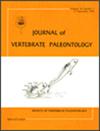滇西宝山上新世羊一组鼠属新种及其伴生小哺乳动物(英文)倪鑫。(2023)滇西宝山上新世羊一组家鼠新种及其伴生小哺乳动物。古脊椎动物杂志。https://doi.org/10.1080/02724634.2023.2249063
IF 1.9
4区 地球科学
Q2 PALEONTOLOGY
引用次数: 0
摘要
摘要:严格意义鼠(sensu stricto)是鼠类中与人类活动关系最密切的一类。在啮齿类动物中,现存鼠种多样性最高,但化石种类较少,主要分布于亚洲,时间跨度为上新世晚期至更新世早期。本文描述了一种晚上新世的鼠属新种,材料来自云南宝山上阳一组。在M1-2和M3上分别保存了t12和t9的臼齿根较少的原始形态特征,以及在下臼齿上发育良好的颊花柱,表明新鼠属是迄今为止鼠属中最原始的形态。在家鼠的牙齿形态中,磨牙有根数逐渐增加、尖牙融合成拱形脊的进化趋势,上颌磨牙的t7和t12减少到消失,m1上的中中央尖牙减少到消失,m1 - 3上的前颊柄减少到消失,m3上的下圆锥减少到消失。宝山新鼠的发现证实了鼠可能起源于晚上新世以前的南亚地区,也为校准鼠与其他鼠类分化的分子钟提供了新的化石证据。此外,我们还报道了5种相关的小型哺乳动物:Neotetracus sp. nov.、Anourosorex qianensis、Soricidae gen. et sp. indet。它们大多生活在温暖潮湿的热带或亚热带山地森林或灌木环境中。该哺乳动物组合的组成表明,宝山地区上新世的古海拔和古气候与现在非常相似。我们感谢IVPP的y.m.h Hou对ct扫描的帮助,以及IOZ的x.c.j Zhu对国家动物收集资源中心现存标本检查的帮助。余吉对化石基质进行筛洗,并对精矿进行分选。我们也感谢编辑和审稿人提出的建设性意见。国家自然科学基金项目(42072209,41888101,41988101,41625005)、第二次青藏高原科学考察与研究计划(批准号:2019QZKK0705)和中国科学院战略重点研究计划(批准号:2019QZKK0705)资助。XDB26000000 XDA20070203)。作者贡献:smjc、QL和XJN设计了这个项目。MJC进行了系统发育分析并起草了稿件。CXZ和XPJ进行了实地调查和资料收集。QL、XJN和CXZ监督这个项目。所有作者都编辑了这份手稿。补充资料1:(1)世界上已报道的鼠化石补充表;(2)补充小鼠左磨牙的理想图形和所选鼠的长度和宽度的95%置信椭圆;(3)补充系统发育分析结果。补充数据2:用TNT分析形态矩阵。声明作者未声明存在潜在的利益冲突。本文章由计算机程序翻译,如有差异,请以英文原文为准。
A new Rattus species and its associated micromammals from the Pliocene Yangyi Formation in Baoshan, western Yunnan, ChinaCitation for this article: Chang, M., Zhang, C., Ji, X., LI, Q., & Ni, X. (2023) A new Rattus species and its associated micromammals from the Pliocene Yangyi Formation in Baoshan, western Yunnan, China. Journal of Vertebrate Paleontology . https://doi.org/10.1080/02724634.2023.2249063
ABSTRACTRattus (sensu stricto) is one of the groups of rodents and is most closely related to human activities. The diversity of extant Rattus species is the highest among rodents, but fossil species are rare, mainly found in Asia during the Late Pliocene to Early Pleistocene. Here, we described a Late Pliocene new species of Rattus based on material from the upper Yangyi Formation in Baoshan county, Yunnan Province, China. The primitive morphological characteristics of fewer molar roots, t12 preserved on M1–2, t9 preserved on M3, and buccal stylids well developed on lower molars indicate that the new Rattus is by far the most primitive form in the Rattus genus. In dental morphology of Rattus, the molars have an evolutionary trend of gradually increasing the number of roots and fusing cusps into an arched ridge, reduction to disappearance of the t7 and t12 on upper molars, and reduction to disappearance of the mesiocentral cusp on m1, the anterior buccal stylid on m1–3 and hypoconid on m3. Discovery of the new Rattus from Baoshan confirms that Rattus probably originated in southern Asia before the Late Pliocene, and also provides new fossil evidence to calibrate the molecular clock of the divergence of Rattus from other murines. In addition, we also reported five associated small mammals: Neotetracus sp. nov., Anourosorex qianensis, Soricidae gen. et sp. indet., Ia io, and Kowalskia sp. Most of them inhabit warm and humid tropical or subtropical montane forests or shrubland environments. The composition of this mammalian assemblage indicates that the paleoelevation and paleoclimate of Baoshan area in the Pliocene are very similar to those of the present. ACKNOWLEDGMENTSWe thank Y. M. Hou from the IVPP for his help with the CT-scans and X. C. Zhu from the IOZ for assistance with extant specimen examination at the National Animal Collection Resource Center. Yu Ji screen-washed the fossiliferous matrix and sorted the concentrates. We also appreciate the constructive comments from the editors and reviewers. The work was supported by the National Natural Science Foundation of China (42072209, 41888101, 41988101, 41625005), Second Tibetan Plateau Scientific Expedition and Research Program (STEP) (Grant No. 2019QZKK0705) and the Strategic Priority Research Program of Chinese Academy of Sciences (Grant No. XDB26000000, XDA20070203).AUTHOR CONTRIBUTIONSMJC, QL, and XJN designed the project. MJC conducted phylogenetic analysis and drafted the manuscript. CXZ and XPJ performed fieldwork and collected materials. QL, XJN, and CXZ supervised the project. All authors edited the manuscript.SUPPLEMENTARY FILESSupplementary Data 1: (1) supplementary table about Rattus fossils reported in the world; (2) supplementary idealized figure of murine left molars and 95% confidence ellipses about length and width of selected Rattus; (3) supplementary phylogenetic analysis results.Supplementary Data 2: morphological matrices analyzed with TNT.DISCLOSURE STATEMENTNo potential conflict of interest was declared by the authors.
求助全文
通过发布文献求助,成功后即可免费获取论文全文。
去求助
来源期刊
CiteScore
2.90
自引率
7.10%
发文量
58
审稿时长
4-8 weeks
期刊介绍:
The Journal of Vertebrate Paleontology publishes original contributions on all aspects of vertebrate paleobiology, including vertebrate origins, evolution, functional morphology, taxonomy, biostratigraphy, phylogenetics, paleoecology, paleobiogeography, and paleoanthropology. JVP publishes high quality peer-reviewed original articles, occasional reviews, and interdisciplinary papers. It is international in scope, and emphasizes both specimen- and field-based based research and the use of high-quality illustrations. Priority is given to articles dealing with topics of broad interest to the entire vertebrate paleontology community and to high-impact specialist studies. Articles dealing with narrower topics, including notes on taxonomic name changes (unless these deal with errors published in JVP), preliminary site reports, and documentation of new specimens of well-known taxa, are afforded lower priority.

 求助内容:
求助内容: 应助结果提醒方式:
应助结果提醒方式:


